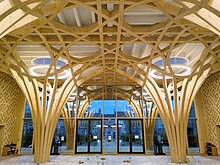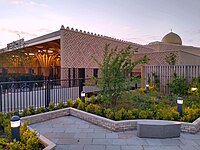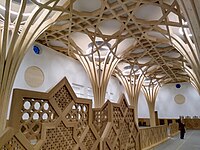| This article contains promotional content. Please help improve it by removing promotional language and inappropriate external links, and by adding encyclopedic text written from a neutral point of view. (October 2024) (Learn how and when to remove this message) |
| Cambridge Central Mosque | |
|---|---|
 Cambridge Central Mosque atrium, facing Mill Road Cambridge Central Mosque atrium, facing Mill Road | |
| Religion | |
| Affiliation | Islam |
| Region | Romsey, Mill Road |
| Status | Active |
| Location | |
| Location | Cambridge, United Kingdom |
| Geographic coordinates | 52°11′49″N 0°09′07″E / 52.197°N 0.152°E / 52.197; 0.152 |
| Architecture | |
| Architect(s) | Marks Barfield |
| Type | Mosque |
| Style | Eco-technology design |
| Completed | Q1 2019 |
| Construction cost | £23 million |
| Specifications | |
| Capacity | 1,000 |
| Dome(s) | 1 |
| Minaret(s) | 0 |
| Materials | Timber, bricks and tiles |
| Website | |
| https://www.cambridgecentralmosque.org/ | |
The Cambridge Central Mosque is Europe's first eco-friendly mosque and the first purpose-built mosque within the city of Cambridge, England. The Cambridge Central Mosque opened to the public on 24 April 2019. The Mosque is a prominent Islamic centre located in Cambridge, England in the Romsey area of Mill Road, which is historically recognised as a place for Cambridge radicals. This mosque is considered as an epicentre; It serves as a place of worship, community centre and cultural hub for Muslims in the area. The mosque is notable for its innovative architecture, sustainable design and commitment to inclusivity.
Background information

Background and development
The project was initiated to address the growing needs of the Muslim community in Cambridge, providing them with a dedicated space for worship, community activities, and cultural events. The area of Mill Road has a rich history of social and political activism, making it a fitting location for a community-oriented project like the mosque.
Concept and design
The idea for the mosque was first proposed in the mid-2000s, with the vision of creating a spiritual and community hub that would be environmentally sustainable and architecturally inspiring. The design competition was held in 2009, and Marks Barfield Architects, the firm behind the London Eye, won with their proposal of a serene oasis within a grove of trees.
The design process involved collaboration with several UK-based experts and artisans:
- Geometer Keith Critchlow
- Garden designer Emma Clark
- Artists Amber Khokhar and Ayesha Gamiet
These collaborations resulted in a mosque that blends traditional Islamic architectural elements with contemporary design principles and local materials. The aim was to create a space that is both spiritually uplifting and environmentally responsible.
Community impact
Since its opening, the Cambridge Central Mosque has become a vital part of the local community. It serves not only as a place of worship but also as a center for educational and social activities. The mosque hosts a variety of events, including religious services, lectures, workshops, and cultural celebrations, promoting inclusivity and understanding among different communities in Cambridge.
Architecture and design
The mosque's architecture is characterised by its contemporary yet culturally sensitive design as it is inspired by both Islamic and English religious architectural traditions. It incorporates elements of Islamic geometry and symbolism, with a focus on creating a welcoming and inclusive environment. It is a one-story building located on a rectangular site which is predominantly the residential area of Cambridge. Visitors walk through a formal garden with trees and a water feature facing the bustling Mill Road before entering the building. Then, the pass underneath a very large entrance canopy supported by four tree-shaped wooden columns. Each of these columns has a large, glazed oculus that allows natural light inside the mosque. (4) The building features a striking timber structure, expressive glulam columns, and a layout that emphasises natural light and ventilation.
Construction and features
The construction of the Cambridge Central Mosque was completed in April 2019. The building is characterised by its timber structure, featuring expressive glulam columns that resemble a forest canopy, symbolising the Islamic tradition of a garden as a place of contemplation and paradise. The mosque's layout emphasises natural light and ventilation, with large glazed oculi allowing sunlight to pour into the prayer hall.
Key architectural features include:
- Tree-shaped wooden columns
- Natural lighting through large oculi
- A formal garden with trees and a water feature
Sustainability
One of the mosque's key features is its commitment to sustainability. It incorporates various green technologies, including natural lighting, ventilation systems, air source heat pumps, photovoltaic arrays, and rainwater harvesting. These features contribute to the mosque's minimal carbon footprint and environmental responsibility. These features contribute to the mosque's minimal carbon footprint and reflect the Islamic principle of stewardship of the Earth.
- Natural Lighting and Ventilation: The mosque uses large skylights and low-energy LED bulbs to maximise natural light and minimise energy consumption. The design also incorporates natural ventilation systems, reducing the need for artificial climate control.
- Renewable Energy: Photovoltaic panels on the roof generate renewable energy. Additionally, the mosque is equipped with highly efficient air source heat pumps that provide heating and cooling, significantly lowering its carbon footprint.
- Water Management: Greywater and rainwater harvesting systems are in place to recycle water for flushing toilets and irrigating the gardens, further enhancing the mosque's sustainability.
- Green Materials: The mosque's timber structure is made from sustainably sourced spruce, which is both environmentally friendly and aesthetically pleasing. This structure is designed to evoke a forest canopy, connecting the building with nature.
- Eco-friendly Transport: The mosque encourages sustainable transportation by providing ample bicycle parking and easy pedestrian access. An underground car park helps maintain the site's green spaces.
Recognition and awards
Since its completion, the Cambridge Central Mosque has received recognition and awards for its architectural excellence and sustainable design. It has been praised for its innovative approach to mosque architecture and its positive impact on the community. In 2021, due to the outstanding design and architecture of the Cambridge Central Mosque it has gained many rewards such as Project Architect of the year, Client of the year and building of the year.
Gallery
See also
| |||||||||||||||||||||||||||||||||
| |||||||||||||||||||||||||||||||||
| |||||||||||||||||||||||||||||||||
| |||||||||||||||||||||||||||||||||
References
- Curtis, Adrian (24 January 2019). "Stunning views of Cambridge's £23m mosque". Cambridge Independent.
- "Welcome to the Cambridge Central Mosque". Cambridge Central Mosque.
- "'Eco mosque' opens for prayers in Cambridge". BBC. 24 April 2019.
- "Home". Cambridge Central Mosque. Retrieved 25 May 2024.
- "Home". Cambridge Central Mosque. Retrieved 25 May 2024.
- "Cambridge Central Mosque | Marks Barfield Architects". Archello. Retrieved 25 May 2024.
- Khan, Mariam (21 September 2021). "Cambridge Central Mosque nominated for UK's best building". newarab.com. Retrieved 25 May 2024.
- "Cambridge Central Mosque: The first Eco Mosque in Europe". Travelling Han. 1 March 2023. Retrieved 25 May 2024.
- "Cambridge Mosque - marksbarfield.com". 13 March 2019. Retrieved 25 May 2024.
- Wilson, Rob (11 November 2019). "Defining the English mosque: Marks Barfield's Cambridge Central Mosque". The Architects’ Journal. Retrieved 25 May 2024.
- "Marks Barfield Architects designs Cambridge Central Mosque held up by tree-like pillars". Dezeen. 20 January 2021. Retrieved 25 May 2024.
- "The Mosque". Cambridge Central Mosque. Retrieved 25 May 2024.
- ^ Teller, Matthew (July–August 2020). "Green Mosques Generate Positive Energy".
- "The Mosque". Cambridge Central Mosque. Retrieved 25 May 2024.
- "Homepage - Architecture Today". Retrieved 25 May 2024.
External links
- Cambridge Central Mosque
- Cambridge Islamic Art - A sister project in aid of Europe's 1st eco-mosque!
- Cambridge Muslim College
Videos
- Cambridge Mosque Project - YouTube.com
- Shaykh Hamza Yusuf on the Cambridge Mosque Project - YouTube.com
- First Look Video The Cambridge Mosque Experience - YouTube.com
- Cambridge Mosque 2011 Summer Stroll Trailer - YouTube.com





